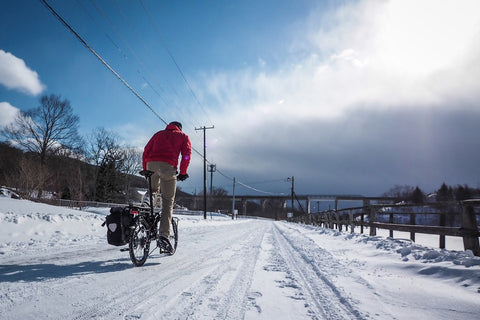How to Stay Safe Cycling in Snow and Ice
The wintry weather forecast shouldn’t put you off cycling outdoors.
During the winter months, snow and ice-covered roads can be treacherous. Some bikers choose not to risk it, but others still get on their bikes despite the risky course.
If you’re determined to keep riding through colder temperatures, preparation is key. This post will outline a few tips for winter cycling to keep you upright and safe.
Winter Cycling

Winter is here. Major roads are blocked and public transit comes to a standstill. Situations like these seem a reasonable choice to ditch the car for a bike.
However, the icy conditions make cycling in snow a risky business - and it should be carefully considered. If going out is necessary or you get caught in a bad place, follow these tips for cycling to stay safe on the road.
Bike safety test
Before you enjoy the winter bike ride experience, get into the habit of doing a safety check. Ensure that your tires and other metal bike components are in their optimum position.
Dress appropriately

You’re likely to be riding slower than your normal pace when winter cycling. In turn, you may not be generating the same levels of heat as you do in warmer months. So unless you want to get daunted by road risks, wear appropriate equipment and clothing.
Winter jackets and thermal leggings won’t be enough. An extra base layer on top of what you’d normally wear is always a good idea.
You’ll also want to pay particular attention to your hands and feet. Ideally, wear gloves with liners. Not only do they reduce the windchill to your hands but also the chilling effect on metal brake levers and bars. Just make sure the gloves have enough room for good circulation.
For your feet, pair your overshoes with thermal socks. Wear a thin pair of “wicking” liner socks, then a heavier pair atop them. The liner socks remove perspiration and quickly transfers it to the thermal outer socks.
Other things to consider:
- Visibility in snow flurries is also important, so wear clear glasses.
- Equip your bike with lights to help mark you out on the snowy and icy roads.
- Bright colours and retro-reflective clothing will help you stand out.
- Pack an extra decent waterproof cover in case of snow or rain to keep your core warm.
Stick to well-used route
Stay away from snow and ice-covered roads. Ice is often at its worst overnight, so if you ride early or later, consider heading out in the middle of the day.
If you don’t have access to an off-road bike, you might prefer busier roads. Turning from the main road can mean more traffic but ensures better surfaces and less ice. And although they’ll be clearer, you still need to take particular care.
It’s also best to have routes and roads you know won't be covered in ice throughout your cold-weather cycling. Other tips for choosing your road:
- Avoid the gutter, including road paint or manhole covers, as ice is likely to form there.
- Be cautious into corners. Scan the road ahead to look for areas where ice may have formed. Aim to pick a dry route through the corner.
Take the primary position

British cycling recommends riding in the ‘primary position’ even in more clement weather. This means positioning yourself in the centre of the bike lane to maximise your line of sight.
In icy conditions this is especially important. For one, there’ll be frozen water, debris and rotting leaves at the side which can be extra risky.
Avoid the front brake
In some scenarios, front brakes won’t slow you down nor will the back stop you. In this case, it’s on ice. You’ll want to make sure to keep maximum traction in the front wheel.
A hard pull on that lever on a slippery surface can result in a loss of traction. If you find yourself on ice, avoid braking altogether. Stay relaxed and pedal smoothly over the hazard.
But if you must brake, unclip one foot, slide it along the ground and gently apply the back brake.
Keep an eye on the weather forecast

(Image Credit: Public Domain Pictures)
The winter weather can be unpredictable, so even when riding a short distance, check the forecast. If you’re living in the city, it may look fine out of your window. But once you’re out in the countryside, expect the temperature to drop significantly.
It always pays to assess the local weather warnings before heading out for a ride. If in doubt, don’t take unnecessary risks.
Maintain a smooth pedalling
Avoiding sudden changes of direction. Keep both feet on the pedals while you are moving and maintain a smooth pedalling action. Don’t ride in too low a gear because it’ll be harder to do so.
Stay cool and don’t panic

You might be feeling the cold but try not to tense up. Stay nice and loose, and keep your head, neck and shoulders relaxed.
If you hit some ice, stay steady, take it slow, and ride it out. It’ll be much easier to work out what the best course of action is if you’re calm and controlled.
Look after your bike

(Image Credit: Wikimedia Commons)
Treat your bike with extra TLC if you’re riding through deep winter. Extra salt and grit on the roads can damage the drivetrain if left to build up.
Wash, dry and lube your two wheels at least every after ride. Also, take the opportunity to check it over for any signs of wear or damage to save yourself from road dilemmas.
Round-up
Sometimes, it’s never the snow that’s the real problem. The hardest part is making the choice to head out and get on the bike. And if you do, it only takes a little pedalling to warm you right up and some preparation for a safe winter ride.








